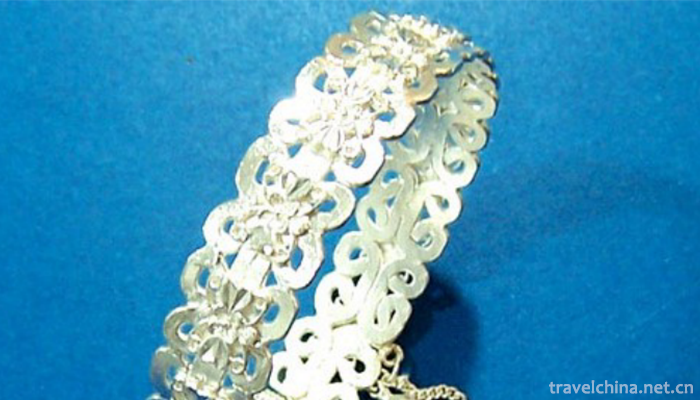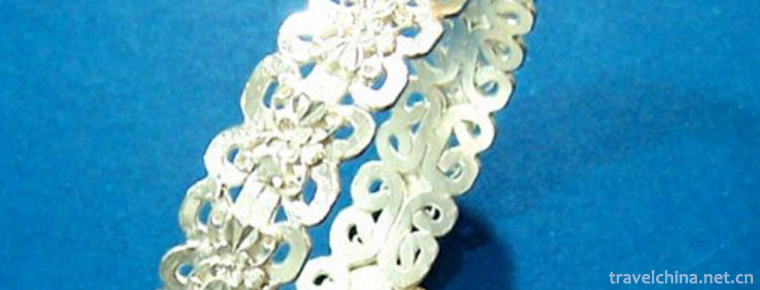Miao Silver Jewelry Forging Techniques
Miao Silver Jewelry Forging Techniques
Miao silver jewelry forging technology, Hunan Fenghuang County, Guizhou Leishan County folk traditional handicraft, one of the national intangible cultural heritage.
Miao silver jewelry forging technology takes silver as raw material. The pattern and structure of silver jewelry have been carefully designed by the craftsmen. There are 30 processes from drawing to carving and making, including casting, blowing, forging, welding, knitting, inlaying, scrubbing and polishing.
On May 20, 2006, Miao silver jewelry forging technology was approved by the State Council and listed in the first batch of national intangible cultural heritage list, project number_-40.
historical origin
The use of silver jewelry in Chinese history can be traced back to the Warring States Period. In the Han Dynasty, Miao and other nationalities had records of silver as a currency in exchange. But this can only show that silver circulated as money in ancient times. Although Miao people spread many ancient legends such as "transporting gold and silver", "supporting the sky with pillars" and "casting the sun and making the moon", the history of Miao silver jewelry is far from so long. It will be several centuries before silver is really used as raw material for forging jewelry.
During the Tang and Song Dynasties, the Central Dynasty set up Jingzhi and Jimi prefectures in the southwest of China, began to strengthen the management of the area, and gradually strengthened the economic and cultural ties between the Han nationality and the various ethnic groups. In the Southern Song Dynasty, because the southwest was far away from the court, it was in a relatively stable state outside the place of power competition. During this period, Zhu Fu's "Ximan Congxiao" recorded that "copper and salt were used as bridal gifts for mountain marriage and engagement". It showed that the value of copper in the southwestern mountain area was the highest at that time. This also further confirms that the Song Dynasty Guizhou minorities did not have the custom of decorating silver.
Records of silver ornaments of Guizhou minorities first appeared in Guo Zizhang's Guizhou Records in the Ming Dynasty, and more and more historical records have been recorded since then, such as "the rich use gold and silver ears, mostly as links", "women's buns, through long hairpins, clothing with earthen cotton, no skirts, when wearing middle holes, to first accept and to wear them", "women wear short shirts, tie double knots on the back, embroidery one side in front of the chest, silver. "Money ornaments", "unmarried people with silver rings ornament ears, number Japanese Malang, marriage off" and so on. It can be clearly seen that there was a sign of "unmarried" with "silver earrings" to distinguish marriage or not, which indicates that the national silver jewelry has a preliminary custom function.
In the Qing Dynasty, records of silver ornaments of ethnic minorities increased significantly. For example, in Gong Chai's Miao Minkao of Qing Dynasty, it is recorded that "the wealthy are like men with four or five silver hairpins, long as daggers, flat upper and lower circles, silver rings in left ears, silver rings in necklaces, silver bracelets in women's clothing, silver rings in necklaces, bracelets and so on. Only the wealthy wear silver combs through their ears and silver combs around their police waists with silver ropes". This shows that at this time the types of silver jewelry gradually increased, not only that, silver jewelry also gradually became popular. Not only are they worn by different genders, but they are also proud of wearing, regardless of age and age, rich or poor. "No age or young, wrists are all about rings, rings are silver." The poorer people can't really wear bracelets, and they are competing to follow the example of "red copper for it".
Therefore, in view of the above historical records, the history of Miao silver jewelry should start in the Ming Dynasty and popularize in the Qing Dynasty. That is to say, from the Qing Dynasty, silver jewelry tended to be popular among all ethnic groups (including Miao), and gradually formed the custom of wearing silver jewelry among Chinese ethnic minorities.
Technological characteristics
Miao silver ornaments are based on their own historical and cultural evolution, with rich and colorful cultural connotations, from the variety of silver ornaments, decorative design structure to production and assembly all reflect a strong national style and high cultural taste. The processing of Miao silver decorations is a unique forging skill of Miao people. Since ancient times, it has been handmade by male silversmiths in family workshops. The style and structure of silver ornaments have been carefully designed by craftsmen, and the process is extremely complex. Even for the same variety, there are often several kinds of shapes.
On technology, the Miao silver jewelry forging techniques mainly include chisel engraving and knitting. According to the needs of stencil or knitting process, silversmiths first make melted silver into thin sheets, silver bars or silk wires. A small piece of silver ornament requires more than ten or more processes, including casting, beating, stencil welding, knitting and washing. Generally speaking, silver ornaments in stencil process are mostly moulded by solid blocks or fabrics, presenting a heavy weight. The sculpture is exquisitely carved on the silver slice. Silver jewelry in knitting process is made by drawing silver bars. Through knitting, various linear decorations are presented, which are exquisite and exquisite.
Miao silver jewelry can also be divided into rough and fine pieces. Rough pieces do not mean rough silver jewelry production, but refer to a large forging process, or large silver jewelry, such as collars, necklaces, bracelets, etc. Fine pieces refer to the need for fine processing, or small pieces of silver jewelry, including large silver accessories, such as silver bells, honeysuckles, silver sparrows, silver butterflies, silver needles, silver bubbles, silver chains, earrings, etc. But this division is not absolute, such as big silver horn, hollow, bubble flower collar, although large, but also need to carve and other fine work, is exquisite and exquisite, skillful.
Inheritance and Protection
Inheritance value
Miao silver jewelry has rich and colorful cultural connotations, from variety, pattern design, pattern construction to production and assembly have a high cultural taste. In diplomatic exchanges, the Miao people give silver jewelry as gifts to their friends, which is as precious as the jewelry of Hada and Han Tibetans.
The Miao silver jewelry creation techniques fully reflect the Miao people's intelligent, smart, kind and friendly national character. Silver jewelry is white and lovely, pure and flawless, and hard in texture, which is the embodiment of Miao's spiritual quality.
Heritage figures
Longmigu, male, Miao, born in 1948 in Shanjiang Town, Fenghuang County, Hunan Province. In June 2009, Longmigu was selected as the representative successor of the third batch of national intangible cultural heritage projects, which was declared by Fenghuang County, Hunan Province.
Ma Maoting, male, Miao, born in 1953 in Huangmaoping Village, Shanjiang Town, Fenghuang County, Hunan Province. In June 2009, Ma Maoting was selected as the representative successor of the third batch of national intangible cultural heritage projects, which was declared by Fenghuang County, Hunan Province.
Yang Guangbin, male, Miao nationality, born in 1963 in Xijiang Town, Leishan County, Guizhou Province. In June 2007, it was identified as the first national intangible cultural heritage Miao silver forging inheritors, Leishan County, Guizhou Province declared.
Wu Shuigen, male, Miao nationality, born in 1966 in Tanglongzhai, Taijiang County, Guizhou Province. In December 2012, he was selected as the representative successor of the fourth batch of national intangible cultural heritage projects and declared in Taijiang County, Guizhou Province.
protective measures
In 2005, the document "Opinions on Strengthening the Protection of China's Intangible Cultural Heritage" issued by the General Office of the State Council, the government provided favorable conditions from the aspects of policy, funds and venues to provide support for the research of Miao silver forging technology inheritance and cultural connotation. At the same time, the local government uses the form of creating Silver Jewelry Culture Festival to develop cultural consumption. Promote the development of local tourism culture and the construction of tourism characteristics of Miao silver jewelry. In 2010, the first Miao silver jewelry forging technology exhibition base was established in Fenghuang folk garden, including Miao silver jewelry museum, Miao silver jewelry production base and Miao silver jewelry research and development center, including protection, inheritance, development and innovation, as well as display and tour in one linkage system. Activities, expositions and cultural festivals. Help the Miao silver jewelry in the public understanding, but also provide a platform for the protection of Miao silver jewelry.
social influence
Important Exhibitions
At the 2002 Tsuen Wan Art Festival, Wu Shuigan, the Miao silver forging inheritor, was invited to demonstrate the whole process of silver jewelry processing. The audience praised his performance.
Honorary recognition
In 2009, Yang Guangbin, the inheritor of Miao silver jewelry forging technology, produced the Miao silver jewelry corolla, which was awarded the prize for the 10th China Arts and Crafts Master's Works and International Art Exhibition "Tianyuan Baihua Cup" for Chinese arts and crafts boutique, and the Miaolong Series and the silk bracelet were collected by the Chinese Academy of Art.


-
2.Beijing Roast DuckPeking duck
Roast duck is a world-renowned Beijing dish, which originated in the Northern and Southern Dynasties of China. It has been recorded in the Record of Food Treasures and was a palace food at that time.P
Time 2018-10-27 -
3.Martial Art
Wushu is a technology inherited from ancient military wars. Martial arts can strengthen the body and defend the enemy
Time 2018-11-13 -
4.Yabuli Ski Resort
Yabuli Skiing Resort is a national AAAA-level scenic spot, located 20 kilometers southeast of Yabuli Town, Shangzhi City, Harbin City, Heilongjiang Province, 240 kilometers away from Harbin City
Time 2018-12-22 -
5.Jinshuitai Hot Spring Scenic Area
Jinshuitai Hot Spring is a hot spring resort built according to the national AAAA scenic standard. It is located in Shuitai Town, Xinxing County, Guangdong Province
Time 2019-01-27 -
6.Crab Island
Crab Island Green Eco-Resort is based on agriculture, characterized by villages, with environmental protection, green, organic and healthy as the solid connotation of tourism and vacation.
Time 2019-02-25 -
7.Canadian Tibetan carpet weaving skills
Canadian Tibetan carpet weaving skills, traditional handicraft in Huangzhong County, Qinghai Province, one of the national intangible cultural heritage.
Time 2019-05-05 -
8.Tie dyeing skills
Tie-dyeing, known as Zha Val, Ge Val, Jia Val and Dye Val in ancient times, is a traditional and unique dyeing process of Chinese folk. A dyeing method in which fabrics are partially tied up so that t
Time 2019-07-16 -
9.Beijing Dancing Academy
Beijing Dance Academy is a full-time ordinary college with the main task of training high-quality dance talents, high-level dance theory research and creation of works. The school, formerly Beijing Da
Time 2019-09-06 -
10.Red Army ferry scenic spot in Cangxi County
Cangxi Red Army ferry is located in Cangxi County, Sichuan Province. There is an ancient ferry by the Jialing River in Tashan Bay 3 km southeast of Cangxi city. Close to the mountain and by the water, the terrain is very dangerous, the rocks are steep, and the trees are green. Jialing River from north to south, beautiful scenery.
Time 2020-11-08 -
11.Summary of Deyang
In 2018, Deyang's GDP reached 221.39 billion yuan, an increase of 9.0% over the previous year at comparable prices. The total economic output has exceeded 200 billion yuan, with per capita GDP of 62569 yuan. Among them, the added value of the primary industry
Time 2020-12-14 -
12.Biological resources in Dazhou
There are more than 400 species of vertebrates in Dazhou City, including 60 kinds of mammals, 230 kinds of birds, 14 kinds of reptiles, 10 kinds of amphibians and 85 kinds of fish. There are 52 species of national and provincial key protected wild an
Time 2020-12-20